Description 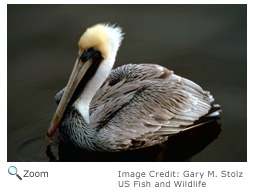 The brown pelican is about four feet tall. It has a brown and gray body and a white head with a light brown crown. Its neck is dark brown during breeding season. Young pelicans are all brown. The brown pelican has a very long gray bill with a large pouch of skin. Its pouch holds two or three times more than its stomach can hold -- close to three gallons of fish and water! Males and females look the same. The brown pelican is about four feet tall. It has a brown and gray body and a white head with a light brown crown. Its neck is dark brown during breeding season. Young pelicans are all brown. The brown pelican has a very long gray bill with a large pouch of skin. Its pouch holds two or three times more than its stomach can hold -- close to three gallons of fish and water! Males and females look the same.
Range  The brown pelican is found on the Atlantic, Pacific, and Gulf Coasts. On the Atlantic Coast, it is found from North Carolina south to Venezuela. On the Pacific Coast, its range stretches from Southern California to Chile. After nesting season, it can be found as far north as British Columbia and Nova Scotia. The brown pelican is found on the Atlantic, Pacific, and Gulf Coasts. On the Atlantic Coast, it is found from North Carolina south to Venezuela. On the Pacific Coast, its range stretches from Southern California to Chile. After nesting season, it can be found as far north as British Columbia and Nova Scotia.
Habitat
The brown pelican is found in coastal areas, like sandy beaches and lagoons. It is also found around waterfronts and marinas.
Diet 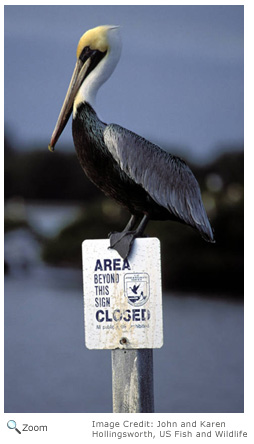 The brown pelican is a plunge diver. It drops from the air with its wings partly folded and dives into the water to catch its prey. It is the only species of pelican that does this! It uses its bill and pouch like a net. It scoops up fish and water. It strains out the water from the sides of its bill, tips back its head, and swallows the fish it caught. It doesn't carry fish in its pouch; it only uses the pouch to scoop up fish. Sometimes gulls will try to steal fish from the pelican's pouch. In fact, they even perch on the pelican's head and wait for just the right moment to grab a fish! The brown pelican eats menhaden, herring, mullet, sheepshead, silversides, and other fish. It also eats crustaceans. The brown pelican is a plunge diver. It drops from the air with its wings partly folded and dives into the water to catch its prey. It is the only species of pelican that does this! It uses its bill and pouch like a net. It scoops up fish and water. It strains out the water from the sides of its bill, tips back its head, and swallows the fish it caught. It doesn't carry fish in its pouch; it only uses the pouch to scoop up fish. Sometimes gulls will try to steal fish from the pelican's pouch. In fact, they even perch on the pelican's head and wait for just the right moment to grab a fish! The brown pelican eats menhaden, herring, mullet, sheepshead, silversides, and other fish. It also eats crustaceans.
| |
Life CycleThe male brown pelican selects a nesting site and then tries to attract a female with a display behavior of head movements. Once a female selects a male, the male brings her sticks, reeds and grass for the nest. The female accepts the materials with a sway of her head and then weaves them into the nest. It can take over a week to build the nest. The nest can be built on the ground, in a tree, or in a bush.
The female lays two to three eggs a few days after the nest is completed. Both parents incubate the eggs and care for the chicks. The eggs are incubated in an unusual way. The pelican puts its webbed feet over the eggs to keep them warm.
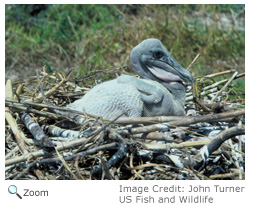 The chicks hatch after about a month. For the first 10 days after hatching, the parents leave regurgitated food on the bottom of the nest for the chicks to eat. After that, the chicks eat regurgitated food directly from their parents' bills. If the nest is on the ground, it may be a simple scrape in the ground, or it may be made of sticks, reeds, and grass like a tree nest. The chicks walk around outside the nest when they are about a month old. If the nest is in a tree, the chicks leave the nest when they are between two and three months old. The chicks hatch after about a month. For the first 10 days after hatching, the parents leave regurgitated food on the bottom of the nest for the chicks to eat. After that, the chicks eat regurgitated food directly from their parents' bills. If the nest is on the ground, it may be a simple scrape in the ground, or it may be made of sticks, reeds, and grass like a tree nest. The chicks walk around outside the nest when they are about a month old. If the nest is in a tree, the chicks leave the nest when they are between two and three months old.
Behavior 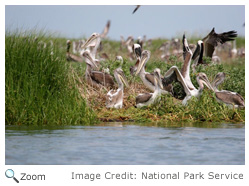 Pelicans live in flocks made up of males and females. In flight, they glide in a V formation or in a straight line, with their necks folded against their shoulders. Pelicans live in flocks made up of males and females. In flight, they glide in a V formation or in a straight line, with their necks folded against their shoulders.
|

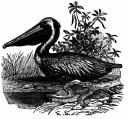

 The brown pelican is found on the Atlantic, Pacific, and Gulf Coasts. On the Atlantic Coast, it is found from North Carolina south to Venezuela. On the Pacific Coast, its range stretches from Southern California to Chile. After nesting season, it can be found as far north as British Columbia and Nova Scotia.
The brown pelican is found on the Atlantic, Pacific, and Gulf Coasts. On the Atlantic Coast, it is found from North Carolina south to Venezuela. On the Pacific Coast, its range stretches from Southern California to Chile. After nesting season, it can be found as far north as British Columbia and Nova Scotia.


